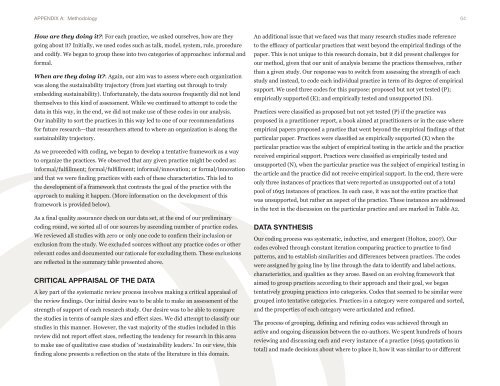embedding sustainability in organizational culture - Network for ...
embedding sustainability in organizational culture - Network for ...
embedding sustainability in organizational culture - Network for ...
You also want an ePaper? Increase the reach of your titles
YUMPU automatically turns print PDFs into web optimized ePapers that Google loves.
appeNdIx Chapter 1: a: Introduction Methodology<br />
64<br />
How are they do<strong>in</strong>g it?: For each practice, we asked ourselves, how are they<br />
go<strong>in</strong>g about it? Initially, we used codes such as talk, model, system, rule, procedure<br />
and codify. We began to group these <strong>in</strong>to two categories of approaches: <strong>in</strong><strong>for</strong>mal and<br />
<strong>for</strong>mal.<br />
When are they do<strong>in</strong>g it?: Aga<strong>in</strong>, our aim was to assess where each organization<br />
was along the <strong>susta<strong>in</strong>ability</strong> trajectory (from just start<strong>in</strong>g out through to truly<br />
<strong>embedd<strong>in</strong>g</strong> <strong>susta<strong>in</strong>ability</strong>). Un<strong>for</strong>tunately, the data sources frequently did not lend<br />
themselves to this k<strong>in</strong>d of assessment. While we cont<strong>in</strong>ued to attempt to code the<br />
data <strong>in</strong> this way, <strong>in</strong> the end, we did not make use of these codes <strong>in</strong> our analysis.<br />
Our <strong>in</strong>ability to sort the practices <strong>in</strong> this way led to one of our recommendations<br />
<strong>for</strong> future research—that researchers attend to where an organization is along the<br />
<strong>susta<strong>in</strong>ability</strong> trajectory.<br />
As we proceeded with cod<strong>in</strong>g, we began to develop a tentative framework as a way<br />
to organize the practices. We observed that any given practice might be coded as:<br />
<strong>in</strong><strong>for</strong>mal/fulfillment; <strong>for</strong>mal/fulfillment; <strong>in</strong><strong>for</strong>mal/<strong>in</strong>novation; or <strong>for</strong>mal/<strong>in</strong>novation<br />
and that we were f<strong>in</strong>d<strong>in</strong>g practices with each of these characteristics. This led to<br />
the development of a framework that contrasts the goal of the practice with the<br />
approach to mak<strong>in</strong>g it happen. (More <strong>in</strong><strong>for</strong>mation on the development of this<br />
framework is provided below).<br />
As a f<strong>in</strong>al quality assurance check on our data set, at the end of our prelim<strong>in</strong>ary<br />
cod<strong>in</strong>g round, we sorted all of our sources by ascend<strong>in</strong>g number of practice codes.<br />
We reviewed all studies with zero or only one code to confirm their <strong>in</strong>clusion or<br />
exclusion from the study. We excluded sources without any practice codes or other<br />
relevant codes and documented our rationale <strong>for</strong> exclud<strong>in</strong>g them. These exclusions<br />
are reflected <strong>in</strong> the summary table presented above.<br />
critical appraisal of the data<br />
A key part of the systematic review process <strong>in</strong>volves mak<strong>in</strong>g a critical appraisal of<br />
the review f<strong>in</strong>d<strong>in</strong>gs. Our <strong>in</strong>itial desire was to be able to make an assessment of the<br />
strength of support of each research study. Our desire was to be able to compare<br />
the studies <strong>in</strong> terms of sample sizes and effect sizes. We did attempt to classify our<br />
studies <strong>in</strong> this manner. However, the vast majority of the studies <strong>in</strong>cluded <strong>in</strong> this<br />
review did not report effect sizes, reflect<strong>in</strong>g the tendency <strong>for</strong> research <strong>in</strong> this area<br />
to make use of qualitative case studies of ‘<strong>susta<strong>in</strong>ability</strong> leaders.’ In our view, this<br />
f<strong>in</strong>d<strong>in</strong>g alone presents a reflection on the state of the literature <strong>in</strong> this doma<strong>in</strong>.<br />
An additional issue that we faced was that many research studies made reference<br />
to the efficacy of particular practices that went beyond the empirical f<strong>in</strong>d<strong>in</strong>gs of the<br />
paper. This is not unique to this research doma<strong>in</strong>, but it did present challenges <strong>for</strong><br />
our method, given that our unit of analysis became the practices themselves, rather<br />
than a given study. Our response was to switch from assess<strong>in</strong>g the strength of each<br />
study and <strong>in</strong>stead, to code each <strong>in</strong>dividual practice <strong>in</strong> term of its degree of empirical<br />
support. We used three codes <strong>for</strong> this purpose: proposed but not yet tested (P);<br />
empirically supported (E); and empirically tested and unsupported (N).<br />
Practices were classified as proposed but not yet tested (P) if the practice was<br />
proposed <strong>in</strong> a practitioner report, a book aimed at practitioners or <strong>in</strong> the case where<br />
empirical papers proposed a practice that went beyond the empirical f<strong>in</strong>d<strong>in</strong>gs of that<br />
particular paper. Practices were classified as empirically supported (E) when the<br />
particular practice was the subject of empirical test<strong>in</strong>g <strong>in</strong> the article and the practice<br />
received empirical support. Practices were classified as empirically tested and<br />
unsupported (N), when the particular practice was the subject of empirical test<strong>in</strong>g <strong>in</strong><br />
the article and the practice did not receive empirical support. In the end, there were<br />
only three <strong>in</strong>stances of practices that were reported as unsupported out of a total<br />
pool of 1695 <strong>in</strong>stances of practices. In each case, it was not the entire practice that<br />
was unsupported, but rather an aspect of the practice. These <strong>in</strong>stances are addressed<br />
<strong>in</strong> the text <strong>in</strong> the discussion on the particular practice and are marked <strong>in</strong> Table A2.<br />
data synthesis<br />
Our cod<strong>in</strong>g process was systematic, <strong>in</strong>ductive, and emergent (Holton, 2007). Our<br />
codes evolved through constant iteration compar<strong>in</strong>g practice to practice to f<strong>in</strong>d<br />
patterns, and to establish similarities and differences between practices. The codes<br />
were assigned by go<strong>in</strong>g l<strong>in</strong>e by l<strong>in</strong>e through the data to identify and label actions,<br />
characteristics, and qualities as they arose. Based on an evolv<strong>in</strong>g framework that<br />
aimed to group practices accord<strong>in</strong>g to their approach and their goal, we began<br />
tentatively group<strong>in</strong>g practices <strong>in</strong>to categories. Codes that seemed to be similar were<br />
grouped <strong>in</strong>to tentative categories. Practices <strong>in</strong> a category were compared and sorted,<br />
and the properties of each category were articulated and ref<strong>in</strong>ed.<br />
The process of group<strong>in</strong>g, def<strong>in</strong><strong>in</strong>g and ref<strong>in</strong><strong>in</strong>g codes was achieved through an<br />
active and ongo<strong>in</strong>g discussion between the co-authors. We spent hundreds of hours<br />
review<strong>in</strong>g and discuss<strong>in</strong>g each and every <strong>in</strong>stance of a practice (1695 quotations <strong>in</strong><br />
total) and made decisions about where to place it, how it was similar to or different
















